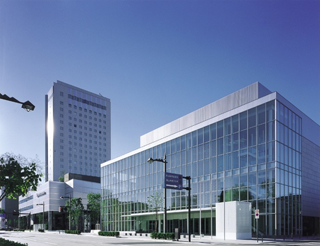Venue & Access
About Toyama
Located approximately in the center of Honshu Island, Japan, Toyama Prefecture combines a rich natural environment with urban amenities. Mountains surround the prefecture on three sides and a deep bay nestles in a crook formed by Toyama’s rolling plains. Toyama Prefecture is compact, spreading out from its capital, Toyama City, only 50km in each direction. Thanks to its central location on the Sea of Japan and a rich history of contact with the Korean Peninsula, mainland Asia and other rim countries, Toyama is at the heart of business and leisure activity in the region.

Venue of Conference
Toyama International Conference Center
[MAP]
1-2 Ote-machi, Toyama City, Toyama 930-0084, Japan
TEL: +81-76-493-4455
FAX: +81-76-493-7170

Access to Toyama(as of : June 1)
1) Direct flight to Toyama
- Toyama ⇔ Seoul (Incheon)
Airlines/Asiana Airlines
Every Tuesday, Friday, Sunday
- Toyama ⇔ Dalian(Zhoushuizi)
Airlines/China Eastern Airlines
Every Monday, Thursday, Friday, Sunday
- Toyama ⇔ Shanghai (Pudong)
Airlines/China Eastern Airlines
Every Tuesday, Saturday
2) Flights connecting at Haneda International Airport(Tokyo)
Haneda’s (Tokyo International Airport) new international terminal, opened October 2010,
is connected to the terminal of domestic flights by train in 5 minutes.
The last flight departing Haneda to Toyama is 19:55.
- Atlanta
Arlines/Delta Airlines
Everyday
Arrival time:22:30 or 23:00
- Bangkok
Airlines/ANA, Thai Airways International, JAL
Everyday
Arrival time:06:40, 06:55, 22:30
- Beijing
Airlines/JAL, ANA, Air China, China Eastern Airlines
Everyday
Arrival time:12:50, 20:15, 21:00, 21:45
- Hong Kong
Airlines/JAL, American Airline, Cathay Pacific Airways
Everyday
Arrival time:13:55, 19:40, 20:25, 21:35
- Las Vegas
Airlines/Delta Airlines(via Los Angels)
Everyday
Arrival time:04:55
- Los Angeles
Airlines/ANA, Continental Airlines, United Airlines, US Airways
Everyday
Arrival time:05:00
- London, LHR
Airlines/British Airways
Every Monday, Thursday, Friday, Saturday, Sunday
Arrival time:04:55
- Paris
Airlines/JAL, Air France
Everyday
Arrival time:06:00
- San Francisco
Arlines/JAL, American Airlines
Everyday
Arrival time:22:35
- Seoul, GMP
Airlines/JAL, Korean Air, Asiana Airlines, ANA
Everyday
Arrival time:10:10, 10:45, 11:05, 14:15, 14:45, 17:35, 18:30, 18:35, 21:05, 21:55, 22:15
- Seoul, ICN
Airlines/Asiana Airlines, ANA, Korean Air
Everyday
Arrival time:03:50, 04:30, 23:20, 23:30
- Shanghai, SHA
Airlines/JAL, China Eastern Airline, ANA, Air China
Everyday
Arrival time:12:30, 13:30, 16:35, 17:40
- Singapore
Airlines/Singapore Airlines, ANA, JAL, American Airlines, Qantas Airways
Everyday
Arrival time:05:15, 05:50, 06:00, 23:05
- Taipei, TSA
Airlines/China Airlines, JAL, ANA, Eva Air
Everyday
Arrival time:12:55, 14:00, 18:00, 19:30, 19:55, 21:00, 21:55
3) from Narita Airport
- by Air
Limousine Bus to Haneda Airport, Terminal 2 (approx. 75mins)
ANA flight to Toyama Airport ( approx. 1 hr)
- by Train
Total Time: Approx. 5 hrs
Total Fare: JPY 14,100
JR "Narita Express" to Tokyo Station. (approx. 85 mins)
JR "Joetsu Shinkansen Max Toki" to Echigoyuzawa Station. (approx. 70 mins)
JR Limited Express "Hakutaka" to Toyama Station. (approx. 2 hrs)
Click here for the timetable
4) from Centrair Airport (Nagoya)
- by Train
Total Time: Approx. 4.5 hrs
Total Fare: JPY 8,440-9,280
Meitetsu Airport Express "μSky"(Musky) to Nagoya Station. (approx. 40 mins)
JR Limited Express "Shirasagi"to Toyama Station. (approx. 3.5 hrs)
or
JR Limited Express "Wide View Hida" to Toyama Station. (approx. 3.5 hrs)
Click here for the timetable
5) from Kansai Airport (Osaka)
- by Train
Total Time: Approx. 4.5 hrs
Total Fare: JPY 10,800
JR Airport Express "HARUKA" to Kyoto Station(approx. 60 mins)
JR Limited Express "Thunderbird" to Toyama Station(approx. 3.5 hrs)
Click here for the timetable
Instruction of Bus Ride from Toyama Airport
Take the bus bound for Toyama Station(

) and get off at “Sogawa #9”(

) for the conference venue. If you also stay at “ANA Crowne Plaza Hotel”, this is the bus stop you should get off.
If you would like to go straight to your hotel, please check the nearest bus stop shown below.
| Hotel |
Bus Stop |
ANA Crowne Plaza Hotel
Tsuruginoyu Dormy Inn Toyama
Daiwa Roynet Hotel
|
Sogawa #9( ) )
|
Toyama Dai-ichi Hotel
Manten Hotel
|
Jo-shi Kouen-Mae#5( ) )
|
Excel Hotel Tokyu
Hotel α-1
Hotel Toyoko-Inn
Hotel Toyoko-Inn Jr.
APA Villa Hotel
|
Toyama Ekimae #6( ) )
|
 The PDF file for printing is available here
The PDF file for printing is available here.
Excursion
Gokayama is a region of precipitous mountains and plunging valleys found in the southeastern part of Toyama. The Ainokura community of Taira village features more than 20 homes built using gassho-zukuri, or sharply sloped thatched gables roofs, so named because their shape resembles hands clasped in prayer, or gassho. The 60-degree angle of the thatch is designed to shed heavy winter snowfall. The village of gassho-zukuri houses was listed as a UNESCO World Heritage Site in 1995, and the strictly seasonal lifestyle of the community has changed little since ancient times. The design of the Murakami residence has remained unchanged for four hundred years and is open to visitors. Gokayama is also famous for Japanese traditional paper called washi, an art practiced in the region for twelve centuries. Washi is highly desirable as a material for arts and crafts.





 ) and get off at “Sogawa #9”(
) and get off at “Sogawa #9”( ) for the conference venue. If you also stay at “ANA Crowne Plaza Hotel”, this is the bus stop you should get off.
) for the conference venue. If you also stay at “ANA Crowne Plaza Hotel”, this is the bus stop you should get off. )
)
 )
)
 )
)

